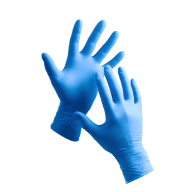Sir Safety System Mirò Extra Coated Glove Blue
SIR SAFETY SYSTEM
visit storeProduct description
Product Features:
- Heavy cotton knit construction
- Abrasion-resistant NBR coating
- Anti-oil finish on palm and back
- Cotton cloth cuff
Standards:
- EN 388 4X32B
- EN ISO 374-1 Type B KLM
- EN ISO 374-5
Determines how the glove secures around the wrist, affecting fit, comfort, and protection coverage at the wrist area.
Full finger coverage provides complete protection for all your digits, ensuring maximum safety.
Enjoy a flexible, comfortable fit that conforms to your hand, enhancing dexterity for precise tasks.
Versatile design for a wide range of tasks, giving you reliable protection and flexibility for diverse jobs.
- Antimicrobial Protection
- Hand Protection
- Chemical Resistance
- Cut Resistant
- Slip Resistant
Request a free sample
Test first and buy later. Visit any product page to request your free sample.
Standards and labels
EN ISO 374-1:2016 is a standard that defines the performance requirements for gloves that protect against chemicals and microorganisms. The standard specifies the design, materials, and testing requirements for gloves to protect against chemicals and microorganisms. Possible test results include measurements of the gloves' permeation resistance, degradation, and penetration. It also includes the safety and functionality requirements for gloves.
Test results
Specified Requirements Type BEN 374-5:2016 is a European standard for gloves that protect against microorganisms, specifically gloves that are used for medical and dental procedures. It sets rules for how the gloves should protect against microorganisms and how to test if they meet the standards. Gloves that pass the tests can have a label that says they meet the standard. The test results can be pass or fail for each test that checks the gloves resistance to microorganisms.
Test results
Micro-organisms Bacteria & FungiEN 374-5:2016 specifies the requirements and test methods for protective gloves intended to protect against bacteria and fungi. The designation 'Bacteria & Fungi' indicates that the gloves have been tested and verified to provide effective barrier protection against microbial agents. The testing involves evaluating the glove's material and seams for their impermeability to microorganisms under conditions that simulate real-world use, ensuring no penetration occurs through the glove material or at the seams. Gloves certified under this standard are crucial for use in environments such as healthcare, laboratory settings, and any applications where preventing the transmission of infectious agents is essential. They help ensure the safety and hygiene of workers by providing reliable protection against the risks of bacterial and fungal contamination.
EN 388:2016 is a European standard for measuring the performance of protective gloves against mechanical risks (abrasion, cut, tear, and puncture). The standard includes test methods and performance requirements for gloves to be considered compliant. Test results are reported using a series of four numbers, each representing the performance level achieved in one of the tests.
Test results
Cut Resistance, ISO 13997 Level BThe Cut Resistance test, ISO 13997, as per standard EN 388:2016, aims to gauge the resistance of protective glove materials against cuts by sharp objects. A test result of Level B means that the protective material can withstand forces between 5 and 10 Newtons before being penetrated. This implies moderate resistance, suitable for tasks like packaging, goods manufacturing, and warehousing. The ISO 13997 test involves using a TDM test device equipped with a straight-edge blade drawn once across the material in a defined direction until penetration occurs. The distance the blade travels before cutting through the material is recorded. This test, with its rigorous measurement of cutting force, is particularly useful for materials that tend to blunt blades, ensuring accurate and reliable performance ratings for gloves specifically meant for mechanical hazards. The practical implication for gloves rated at Level B is they offer moderate protection suitable for industries with moderate cut hazards, thus ensuring user safety in specific working environments like logistics or light manufacturing.
Abrasion Resistance Level 4EN 388:2016 uses a specific test method to measure abrasion resistance of safety gloves; the gloves’ material is subjected to sandpaper under pressure to observe the number of cycles needed to wear through the material. Level 4 in this standard indicates that the material withstood 8,000 cycles before a hole was made. Practically, this means that gloves rated at Level 4 for abrasion resistance offer very high resilience against wearing through, making them suitable for tasks involving significant contact with rough surfaces .
Puncture Resistance Level 2The standard EN 388:2016 includes an assessment of Puncture Resistance, where Level 2 signifies that the material has met specific criteria for resistance against puncture. The result of Level 2 in puncture resistance means that the protective glove or material can withstand a force of 60 to 100 newtons before being punctured. The test method used involves using a standardized steel puncture probe that is pushed against the material at a specified speed until it pierces through it. In essence, achieving a Level 2 puncture resistance under EN 388:2006 suggests that the protective equipment offers moderate protection against punctures, making it suitable for environments where there is a risk of encountering sharp objects such as needles, but are not excessively sharp or exert very high force.
Tear Resistance Level 3EN 388:2016 is a European standard that specifies methods for testing the resistance of protective gloves against mechanical hazards, such as abrasion, cuts, punctures, and tearing. The Tear Resistance Level 3 indicates a high level of protection, where the gloves can withstand significant tearing forces. The test for determining tear resistance involves subjecting the glove material to a mechanical force until it tears, measuring the force required to initiate and continue the tear. For Level 3, gloves must withstand a force between 50 to 75 Newtons before tearing. This robust level of tear resistance is particularly suitable for demanding environments where gloves are exposed to activities that might cause extensive wear or tearing, such as handling heavy or rough materials, industrial assembly, and construction tasks. Gloves with this level of tear resistance provide enhanced durability and safety, reducing the risk of injuries and increasing the longevity of the glove in tough working conditions.
ISO 14001:2015 is a standard that specifies requirements for an environmental management system (EMS). It includes requirements for how companies should design, implement, maintain and improve their EMS to ensure that they minimize negative impacts on the environment and comply with environmental regulations. Test results can include information on how well the EMS is functioning, how well it is being followed, and how effective it is in reducing environmental impacts. The standard also includes requirements for how the company should document and record their EMS performance and continuously improve it.
Test results
Environmental Management PassedThe standard ISO 14001:2015 pertains to environmental management systems (EMS). A passed test result under this standard indicates that an organization's EMS meets the stringent criteria set forth for managing environmental responsibilities systematically. This ensures sustainable development while considering environmental impacts. Specifically, ISO 14001:2015 includes requirements for a framework that an organization can follow rather than establishing environmental performance criteria. It encompasses various aspects such as compliance obligations, planning actions to address risks and opportunities, and continual improvement. The test primarily involves evaluating the effectiveness of the EMS in supporting a company to achieve its intended outcomes regarding its environmental performance. If a company has passed this evaluation, it reflects their commitment to environmental stewardship, potentially enhancing their marketability and aiding in compliance with statutory and regulatory requirements.
Test results
Service Reliability PassedEN ISO 9001:2015 is a globally recognized standard that specifies requirements for a quality management system (QMS), focusing on numerous aspects of quality management in organizations, aiming to enhance customer satisfaction through the effective application of the system. The 'Service Reliability' with a 'Passed' designation indicates that an organization has successfully demonstrated its ability to consistently provide services that meet customer and regulatory requirements while aiming for continual improvement. This assessment involves evaluating various elements of the QMS including service planning, execution, and monitoring, to ensure reliability and performance consistency. The practical implications for organizations that pass this aspect of the standard are significant; it establishes them as reliable providers in their industry, enhancing customer trust and satisfaction, and potentially leading to increased business and a competitive advantage.
Test results
General Requirements GuideEN ISO 21420:2020 is a standard that outlines general requirements and guidelines for protective gloves, aiming to ensure their quality, performance, and suitability for various applications. When a product meets the requirements outlined in the General Requirements section of EN ISO 21420:2020, it signifies that the gloves comply with fundamental quality and performance criteria, including factors such as size, fit, ergonomics, and dexterity. The practical implications of this compliance are significant, as it assures users of the gloves' basic functionality and suitability for general hand protection purposes across a range of industries and applications. The test method involves evaluating various aspects of the gloves, including dimensions, construction, materials, and labeling, to ensure conformity with the specified requirements. Compliance with these general requirements enhances user confidence in the protective gloves' reliability and effectiveness, promoting workplace safety and facilitating compliance with regulatory standards.
CE Marking is a label that shows a product meets certain safety and environmental standards set by the European Union. To get the CE Marking, a company must test and certify their product meets these standards. CE Marking is required for many products sold in the EU, including electronics, machinery, toys and medical devices. It helps ensure that products are safe for consumers and the environment, and allows for easy trade within the EU.
PPE stands for "personal protective equipment." PPE Category 3 refers to equipment that is complex and provide the highest level of protection such as powered respirators, SCBA, and full body suits. In Europe, PPE Category 3 must meet certain safety standards set by the European Union, which means that it must be designed and manufactured to protect the user without causing harm. Companies that make or sell PPE must prove that it meets these standards. They also must have a quality management system in place, have to be audited regularly by a notified body and have to have a technical documentation.
SIR SAFETY SYSTEM delivery terms
Free delivery when you order more than 1 650,00 kr from SIR SAFETY SYSTEM
Supplier shipping fee 60,00 kr
Brand minimum 1 500,00 kr
381,14 kr
Price per 12 pairs
31,76 kr / pair
Shipping fee is 60,00 kr for orders under 1 650,00 kr
A package contains 12 pairs
Need larger quantities?
Other products you may like
Recently viewed
Need help?
Get help from our experts
Other products you may like
Similar products you may like



Find +150,000 products from hundreds of brands
Autonomous sourcing platform
The most efficient way to source and order supplies for your operations
Sourcing
Ordering
List products you’re looking for and we’ll find the best products and prices for you – all for free.
Need help?
Get help from our experts
